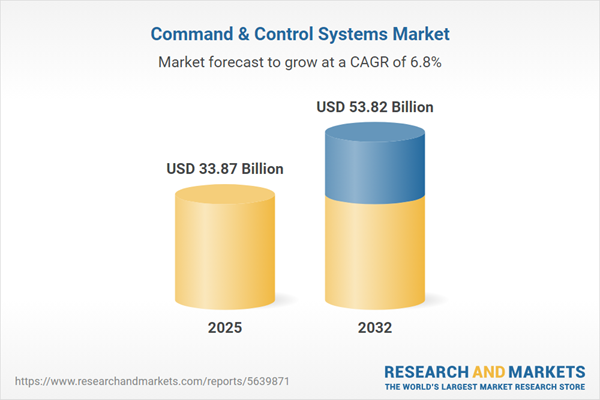Speak directly to the analyst to clarify any post sales queries you may have.
The Command & Control Systems Market is rapidly adapting to the needs of interconnected defense, civilian, and security stakeholders, offering robust solutions for real-time decision support and operational agility. Leaders across sectors rely on market-driven innovation, regulatory foresight, and strategic partnerships to maintain preparedness within complex and evolving environments.
Market Snapshot: Growth and Competitive Landscape in the Command & Control Systems Market
The Command & Control Systems Market grew from USD 31.84 billion in 2024 to USD 33.87 billion in 2025. Projected at a compound annual growth rate (CAGR) of 6.78%, the market is expected to reach USD 53.82 billion by 2032. This trajectory highlights steady global investment, particularly in technology-driven modernization, supply chain resilience, and cross-domain integration. Established defense suppliers and emerging technology leaders are expanding offerings to address these evolving command requirements.
Scope & Segmentation: Comprehensive Market Coverage
This report delivers a detailed analysis of the Command & Control Systems Market, examining dynamics across key segments and regions:
- Components: Hardware solutions such as communication devices, IT infrastructure, and sensor technologies; Services including logistics, maintenance, training, and system engineering; and Software applications for infrastructure safety, situational awareness, and security management.
- Platforms: Airborne assets encompassing both manned and unmanned systems; Land systems including commercial installations, command centers, and vehicles; Maritime assets for commercial shipping, naval operations, and submarines; and Space-focused platforms with satellite and orbital command interfaces.
- Applications: Civil and commercial use in critical infrastructure, energy grids, and logistics; Governmental applications spanning disaster management, homeland security, public safety, and law enforcement; and Military use for air defense, battle management, and cyber or electronic warfare operations.
- Regions: Americas (including North America and Latin America), Europe, Middle East, Africa, and Asia-Pacific, with detailed country-level analysis reflecting varying procurement priorities, regulatory structures, and regional challenges.
- Companies: In-depth company profiles and recent developments for leading firms such as Airbus Defence and Space SAS, BAE Systems PLC, CACI International Inc, Elbit Systems Ltd., and others, illustrating diverse innovation strategies and competitive positioning.
Key Takeaways
- Emerging technologies, including artificial intelligence and resilient network architectures, are redefining how command and control functions are delivered and maintained.
- Cross-platform integration, involving land, air, maritime, and space assets, enables a more comprehensive situational awareness and accelerates response capabilities for both defense and civilian applications.
- Industry partnerships—especially between defense contractors, software providers, cybersecurity firms, and sensor specialists—are critical to providing end-to-end solutions tailored to shifting threat landscapes.
- Customizable service offerings, encompassing everything from live deployments to advanced simulation environments, are becoming increasingly important in vendor differentiation.
- Demand for advanced supply chain transparency and digital risk management is leading to greater adoption of digital tracking and monitoring systems throughout procurement and manufacturing processes.
Tariff Impact: U.S. Trade Measures and Supply Chain Strategies
The 2025 implementation of new U.S. tariffs has notably impacted procurement and supply chain models for command and control system components. Industry participants are strategically reassessing supplier portfolios, increasing inventory buffers, and exploring alternative sourcing arrangements to uphold continuity while mitigating the effects of cost escalation and regulatory complexity. Heightened focus on supply chain transparency is promoting enhancements in digital monitoring and risk management capabilities.
Methodology & Data Sources
This report synthesizes primary research with senior executives, procurement experts, and system integrators, complemented by a thorough review of defense publications, policy documents, and open-source intelligence. Quantitative data were corroborated by expert forecasts, financial disclosures, and a multi-layer validation process to ensure accuracy and analytical depth.
Why This Report Matters
- Enables senior decision-makers to benchmark their strategies against evolving global market dynamics and regulatory shifts.
- Delivers actionable insights for technology adoption, partnership ecosystems, and supply chain risk mitigation within the command and control sector.
- Provides clarity on the competitive landscape and helps identify collaboration opportunities across established defense primes and innovative technology entrants.
Conclusion
The Command & Control Systems Market continues its transformation, driven by technology convergence, adaptive strategies, and global pressures. Organizations equipped with insights from this report are better positioned to maintain operational readiness while addressing tomorrow’s mission-critical challenges.
Additional Product Information:
- Purchase of this report includes 1 year online access with quarterly updates.
- This report can be updated on request. Please contact our Customer Experience team using the Ask a Question widget on our website.
Table of Contents
3. Executive Summary
4. Market Overview
7. Cumulative Impact of Artificial Intelligence 2025
Companies Mentioned
The companies profiled in this Command & Control Systems market report include:- Airbus Defence and Space SAS
- BAE Systems PLC
- CACI International Inc
- Elbit Systems Ltd.
- General Dynamics Mission Systems, Inc.
- Honeywell International Inc.
- Indra Sistemas, S.A.
- Israel Aerospace Industries Ltd.
- Kongsberg Gruppen ASA
- L3 Harris Technologies, Inc.
- Leonardo S.P.A.
- LIG Nex1 Co., Ltd.
- Lockheed Martin Corporation
- Mercury Systems, Inc.
- Northrop Grumman Systems Corporation
- Rheinmetall AG
- Rolta Incorporated
- RTX Corporation
- Saab AB
- Siemens AG
- Sierra Nevada Corporation
- Thales Group
- The Boeing Company
Table Information
| Report Attribute | Details |
|---|---|
| No. of Pages | 184 |
| Published | November 2025 |
| Forecast Period | 2025 - 2032 |
| Estimated Market Value ( USD | $ 33.87 Billion |
| Forecasted Market Value ( USD | $ 53.82 Billion |
| Compound Annual Growth Rate | 6.7% |
| Regions Covered | Global |
| No. of Companies Mentioned | 24 |









